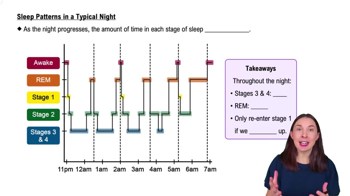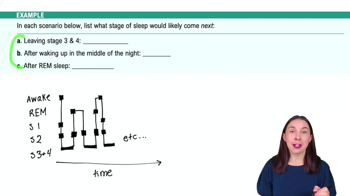Table of contents
- 1. Introduction to Psychology1h 43m
- 2. Psychology Research2h 20m
- 3. Biological Psychology2h 41m
- 4. Sensation and Perception28m
- 5. Consciousness and Sleep32m
- 6. Learning41m
- 7. Memory34m
- 8. Cognition37m
- 9. Emotion and Motivation35m
- 10. Developmental Psychology33m
- 11. Personality48m
- 12. Social Psychology41m
- 13. Stress and Health41m
- 14. Psychological Disorders44m
- 15. Treatment47m
5. Consciousness and Sleep
Sleep
Struggling with Psychology?
Join thousands of students who trust us to help them ace their exams!Watch the first videoMultiple Choice
A hypnic jerk is likely to occur during
A
REM sleep.
B
N2 sleep.
C
microsleeps.
D
N1 sleep.
 Verified step by step guidance
Verified step by step guidance1
Understand the concept of a hypnic jerk: A hypnic jerk, also known as a sleep start, is an involuntary muscle twitch that occurs as a person is beginning to fall asleep.
Identify the stages of sleep: Sleep is divided into several stages, including N1, N2, N3 (non-REM sleep stages), and REM sleep.
Recognize the characteristics of N1 sleep: N1 is the first stage of non-REM sleep and is a light sleep stage where a person transitions from wakefulness to sleep. It is during this stage that hypnic jerks are most likely to occur.
Differentiate between sleep stages: REM sleep is characterized by rapid eye movement and dreaming, while N2 and N3 are deeper stages of non-REM sleep. Microsleeps are brief episodes of sleep that occur when a person is awake.
Conclude that hypnic jerks are most likely to occur during N1 sleep, as this is the stage where the transition from wakefulness to sleep happens, making it the correct answer.

 3:25m
3:25mWatch next
Master Circadian Rhythms with a bite sized video explanation from Hannah Gordils
Start learningRelated Videos
Related Practice


































































































![Race, Genes and IQ Differences | Bret Weinstein [Mini Clip]](https://img.youtube.com/vi/IztL_m3pd70/mqdefault.jpg)



































































































